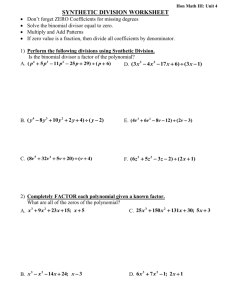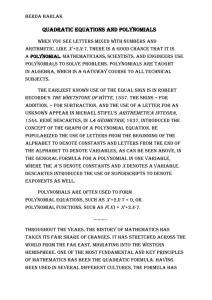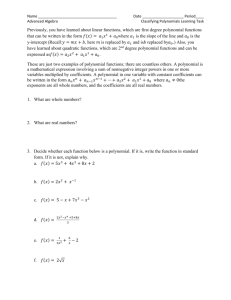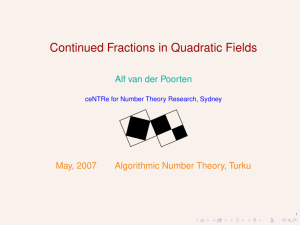Guidelines for Partial Fractions
advertisement
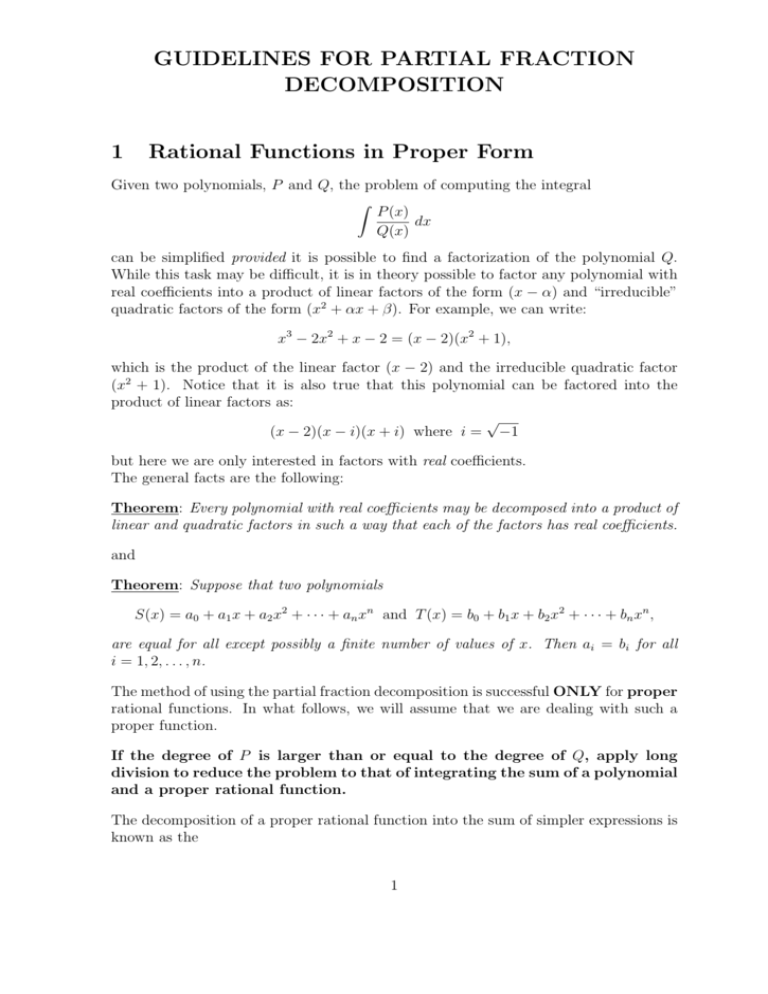
GUIDELINES FOR PARTIAL FRACTION DECOMPOSITION 1 Rational Functions in Proper Form Given two polynomials, P and Q, the problem of computing the integral Z P (x) dx Q(x) can be simplified provided it is possible to find a factorization of the polynomial Q. While this task may be difficult, it is in theory possible to factor any polynomial with real coefficients into a product of linear factors of the form (x − α) and “irreducible” quadratic factors of the form (x2 + αx + β). For example, we can write: x3 − 2x2 + x − 2 = (x − 2)(x2 + 1), which is the product of the linear factor (x − 2) and the irreducible quadratic factor (x2 + 1). Notice that it is also true that this polynomial can be factored into the product of linear factors as: √ (x − 2)(x − i)(x + i) where i = −1 but here we are only interested in factors with real coefficients. The general facts are the following: Theorem: Every polynomial with real coefficients may be decomposed into a product of linear and quadratic factors in such a way that each of the factors has real coefficients. and Theorem: Suppose that two polynomials S(x) = a0 + a1 x + a2 x2 + · · · + an xn and T (x) = b0 + b1 x + b2 x2 + · · · + bn xn , are equal for all except possibly a finite number of values of x. Then ai = bi for all i = 1, 2, . . . , n. The method of using the partial fraction decomposition is successful ONLY for proper rational functions. In what follows, we will assume that we are dealing with such a proper function. If the degree of P is larger than or equal to the degree of Q, apply long division to reduce the problem to that of integrating the sum of a polynomial and a proper rational function. The decomposition of a proper rational function into the sum of simpler expressions is known as the 1 2 The Method of Partial Fraction Expansions We divide the method into four cases, depending on the nature of the real factors of Q. Case 1 : The denominator Q can be factored into linear factors all different: Q(x) = (x − a1 )(x − a2 ) · · · (x − ar ), with no two of the ai the same. In this case we can decompose the ratio P/Q so that P (x) A1 A2 Ar = + + ··· + , Q(x) (x − a1 ) (x − a2 ) (x − ar ) where A1 , A2 , . . . , Ar are appropriately chosen coefficients. Example 1: If we wish to find the partial fraction decomposition of (x2 + 2x + 3) (x3 − x) we write (x2 + 2x + 3) A1 A2 A3 = + + , 3 (x − x) x (x − 1) (x + 1) which is an identity for all x, x 6= 0, 1, −1 if and only if x2 + 2x + 3 = A1 (x − 1)(x + 1) + A2 x(x + 1) + A3 x(x − 1). Collecting like powers of x, we have x2 + 2x + 3 = (A1 + A2 + A3 )x2 + (A2 − A3 )x − A1 . Using the second theorem above, for the two polynomials to be equal, the coefficients of like powers of x must match so that we have −A1 = 3 by matching the constant terms. Then A2 − A3 = 2 and − 3 + A2 + A3 = 1. It follows that the correct partial fraction decomposition is (x2 + 2x + 3) −3 3 1 = + + . (x3 − x) x (x − 1) (x + 1) Case 2 : The polynomial Q can be factored into linear factors, some of which are repeated: Q(x) = (x − a1 )s1 (x − a2 )s2 · · · (x − ar )sr . In this case, a factor of the form (x − a)q gives rise to the terms A1 A2 A3 Aq + + + ··· + . 2 3 (x − a) (x − a) (x − a) (x − a)q 2 Example: To find the partial fraction decomposition of (x3 (x + 5) − 3x + 2) we note that x3 − 3x + 2 = (x − 1)2 (x + 2). This is the Case 2 situation and we look for a decomposition in the form (x3 (x + 5) A1 A2 A3 = + + . 2 − 3x + 2) (x − 1) (x − 1) (x + 2) Multiplying both sides through by (x − 1)2 (x + 2) we get x + 5 = A1 (x − 1)(x + 2) + A2 (x + 2) + A3 (x − 1)2 . Following the same procedure as in the previous example leads to A1 = − 13 , A2 = 2, and A3 = 13 . Case 3 : The polynomial Q can be factored into linear and quadratic factors, and none of the quadratic factors is repeated: Q(x) = (x−a1 )s1 (x−a2 )s2 · · · (x−ar )sr (x2 +b1 x+c1 )(x2 +b2 x+c2 ) · · · (x2 +b` x+c` ). In this case, each unrepeated quadratic factor gives rise to a term of the form Ax + B + bx + c x2 Example: 3x2 + x − 2 A1 A2 x + A 3 = + 2 (x − 1)(x + 1) (x − 1) x2 + 1 or 3x2 +x−2 = A1 (x2 +1)+(A2 x+A3 )(x−1) = (A1 +A2 )x2 +(A3 −A2 )x+(A1 −A3 ). which yields A1 = 1, A2 = 2, and A3 = 3. Case 4 : The polynomial Q can be factored into linear and quadratic factors, and some of the quadratic factors are repeated. In this case, factors of the form (x2 + bx + c)q give rise to terms A1 x + A2 A3 x + A4 A 5 x + A6 A2q−1 x + A2q + 2 + 2 + ··· + 2 . 2 2 3 x + bx + c (x + bx + c) (x + bx + c) (x + bx + c)q Example: 2x3 + 3x2 + x − 1 A1 A 2 x + A3 A4 x + A 5 = + 2 + 2 2 2 (x + 1)(x + 2x + 2) (x + 1) (x + 2x + 2) (x + 2x + 2)2 which, after extensive (and tedious) algebra, yields A1 = −1, A2 = 1, A3 = 3, A4 = −2, and A5 = −3. 3

